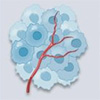| Sep 23, 2024 |
|
(Nanowerk News) In a study published in Nature Nanotechnology (“A cuproptosis nanocapsule for cancer radiotherapy”), Prof. GU Zhanjun from the Institute of High Energy Physics of the Chinese Academy of Sciences, in collaboration with Dr. YAN Junfang and Dr. ZHANG Fuquan from the Peking Union Medical College Hospital, discovered that cuproptosis may serve as a new target for radiosensitization in re-irradiation.
|
|
In cancer treatment, patients who undergo secondary radiotherapy often face the dual challenge of acquired radiation resistance in tumour cells and weakened physical condition, making re-irradiation a significant clinical challenge. This is especially true for advanced cancer patients and elderly individuals who have a pressing need for radiosensitizing drugs during clinical radiotherapy.
|
|
Using synchrotron radiation facilities, researchers for the first time found that cuproptosis-related proteins in tumour tissues were highly expressed under X-ray irradiation, and revealed a novel cell death mechanism induced by copper ions – cuproptosis which could serve as a new target for radiosensitization.
|
|
Based on this, researchers designed and synthesized a copper-containing polyoxometalate, named PWCu, as a targeted radiosensitizer for re-irradiation.
|
|
The PWCu nanocapsules can enter tumour cells, release copper ions during radiotherapy to trigger cuproptosis, overcoming acquired radiation resistance in tumours. In addition, they can activate an abscopal effect, inducing immunogenic cell death and stimulating an antitumour immune response.
|
|
These findings suggested that the PWCu nanocapsules offer a multifaceted strategy that not only enhances the local antitumour effects of radiotherapy but also activates systemic antitumour immunity. The potential of this strategy to improve patient outcomes, especially in the context of recurrent and metastatic diseases, is immense.
|
|
Besides, researchers established advanced analytical methods using synchrotron radiation facilities to study the oxidation states, biological distribution, and metabolic transformation of copper ions within tumour tissues, providing direct methodological support for the research on structure-function relationships and metabolic processes of cupper drug-based radiosensitizers, which is essential for preclinical safety and pharmacokinetic evaluation.
|
|
This study offers a new solution to the clinical challenge of re-irradiation in cancer patients, with significant academic significance and promising clinical applications.
|

